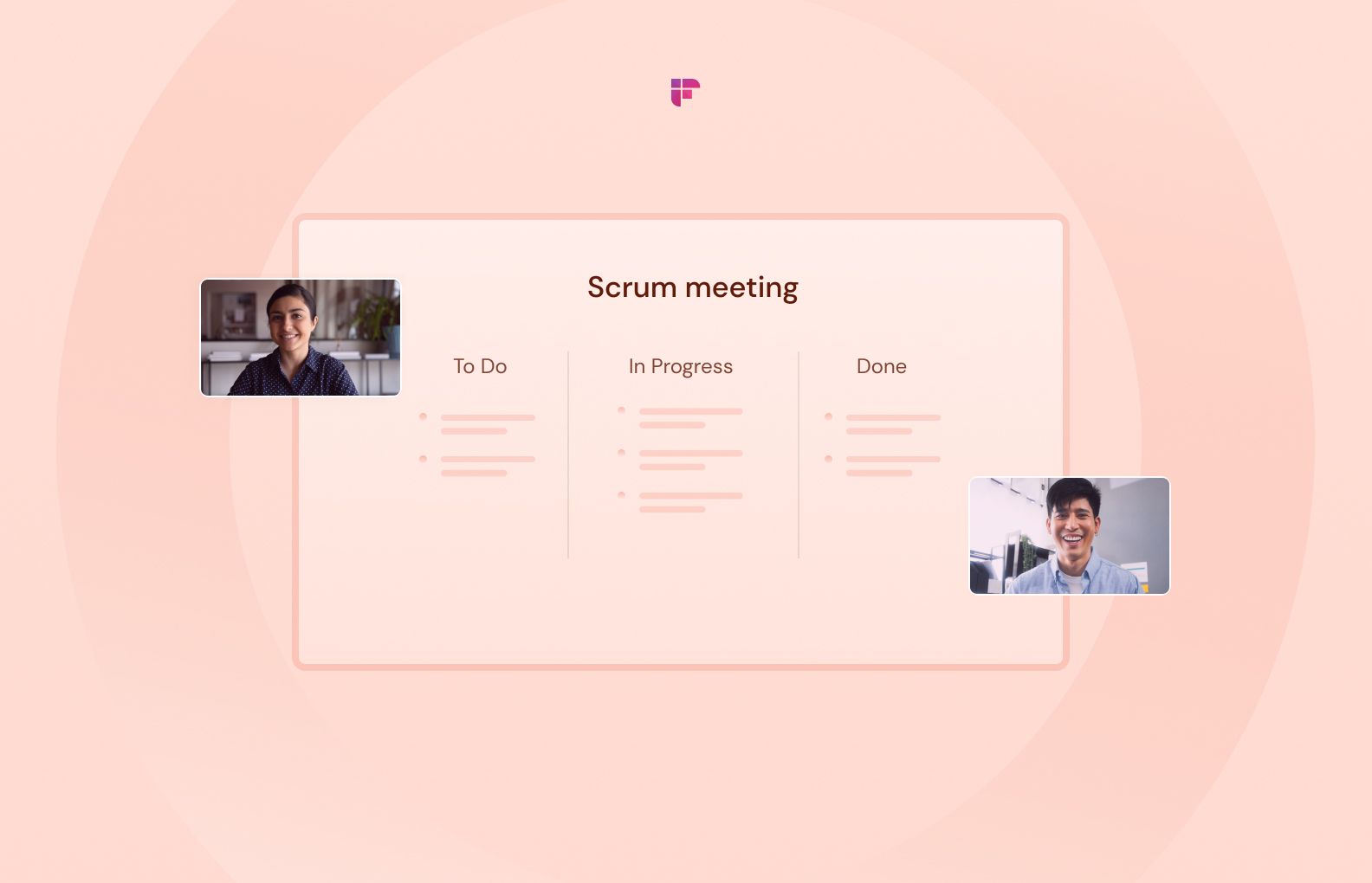Retrospective meetings, also known as sprint retrospective, are dedicated team meetings held at the end of a project iteration, sprint, or time period to reflect on the team's performance and identify areas for improvement.
It provides an opportunity for the team to review what went well and what could have been done better, as well as collectively plan actions to enhance future outcomes.
That being said, it can be challenging to conduct effective retrospective meetings without proper planning and facilitation. The idea of this meeting is to encourage teams and ensure everyone's on the same page. However, these meetings can have quite the opposite effect if not planned well.
In this blog post, you'll find eight value-packed tips to help you plan & conduct retrospective meetings well. Read on!
8 tips for conducting productive retrospective meetings

Check out eight vital tips you can implement to hold a successful sprint retrospective meeting:
- Have a meeting agenda
- Create a safe environment
- Ask the right questions
- Be consistent
- Document everything
- Induce some excitement
- Create an action plan
- Get feedback
Use Fireflies, the AI Notetaker tool, to automatically record, transcribe, summarize, and analyze your conversations with 90%+ accuracy.
1. Have a meeting agenda
Having an agenda is essential for a productive retrospective, as it serves as a guide if the discussion veers off track.
Sharing the agenda before the meeting is also important because it gives team members enough time to prepare. The retrospective meeting agenda should consist of actionable items aimed at preventing the repetition of past project errors.
By providing structure and focus, the agenda streamlines the flow of the meeting, ensuring that the team's valuable time is not wasted.


2. Create a safe environment
Retrospective meetings should be collaborative and form a safe environment where team members feel valued.
To achieve this, encourage your team to note observations throughout the project and review key objectives and events during the retrospective. Safety is paramount, so try to establish clear expectations with rules of engagement.
By breaking down the wall of fear, your team can address its concerns and improve the effectiveness of your meeting.
3. Ask the right questions
Asking the right questions is crucial for a productive retrospective. It enables a fresh perspective, stimulates creativity, and uncovers opportunities. Some important questions to consider include:
- Did we achieve desired results and have an impact?
- How well did we adapt to changes or unexpected circumstances?
- Which techniques or tools were effective or ineffective?
- What were the necessary but challenging aspects?
- What were the most valuable lessons we learned from this project?
- How can we apply the insights gained from this project to future endeavors?
4. Be consistent
Consistency is key for productive retrospective meetings. Establishing and sticking to a regular schedule helps teams reflect and uncover valuable insights.
Now, the frequency of your retrospective meetings depends on various factors. For instance, if your team works with longer sprint durations, holding a retrospective once every couple of months may be sufficient.
On the other hand, if your team follows shorter sprints, it's okay to have one or two retrospectives per month.
Striking the right balance is challenging because having too many or too few retrospectives can harm the overall project.
Retrospective meetings should be held frequently enough to remain valuable, yet not so infrequently that important issues are forgotten.

5. Document everything
Taking detailed notes during retrospective meetings is essential to capture the topics and actions discussed. These notes can also serve as valuable data for future sprints.
An AI meeting assistant like Fireflies can record, transcribe, summarize, and take notes of all your retrospective meetings. This ensures that meeting discussions are accurately captured and documented, allowing for efficient referencing later.
Plus, Fireflies automatically sends meeting recaps to all attendees (based on your meeting settings) for effective follow-ups.
6. Induce some excitement
Retrospectives can sometimes feel tense, especially for teams new to the process or uncertain about sharing their thoughts honestly. Since these meetings can be lengthy, find ways to keep participants engaged.
To keep things interesting, you can vary your approach by:
- Rotating leadership: Assign different team members as facilitators for each retrospective. This rotation allows everyone to take ownership of the process and brings diverse facilitation styles and perspectives.
- Incorporating gamification: Use game formats like trivia, quizzes, or role-playing exercises to encourage active participation and create a sense of fun.
- Experimenting with Formats: Don't be afraid to experiment with different retrospective formats. For example, try a fishbowl discussion, silent brainstorming, or a World Café-style setup. By varying the format, you introduce novelty and encourage different modes of thinking and engagement.
- Switching Exercises: Instead of sticking to the usual "what went well/not so well" routine, explore different ways to analyze data, generate ideas, narrow down solutions, and encourage participation.
- Using visualizations: Use diagrams, flowcharts, mind maps, or infographics to visually represent data and facilitate discussions. Visualizations can make the information more digestible and stimulate new insights.
7. Create an action plan
Formulate a detailed plan to integrate the ideas presented during the meeting into future projects. To ensure clarity, explicitly identify the individuals responsible for executing these ideas.
Consider incorporating these assignments into a shared huddle board to maintain organization and accessibility throughout the process.
8. Get feedback
Finally, create an environment where the team can share feedback beyond discussing challenges and successes. Encourage them to provide constructive input to help the team work more efficiently together.
Why retrospective meetings are important
For any agile team, a sprint retrospective meeting represents the benchmark of excellence. Here are some reasons why these meetings are so important:
- Encourages team bonding
- Aids team learning and development
- Sets more realistic expectations
- Increases customer value
- Boosts transparency
- Identifies blockers in work processes
- Improves planning and structure for future projects
- Enhances productivity
1. Encourages team bonding
Retrospective meetings provide an official opportunity for teams to openly share their thoughts, thus creating a safe and comfortable environment. Some teams even use this time to engage in team-building activities, which helps to strengthen their bond.
2. Aids team learning and development
Retrospective meetings are ideal for reflecting on past experiences, enabling teams to grow and avoid repeating mistakes.
3. Sets more realistic expectations
These meetings offer an opportunity to recap the entire process and assess whether initial expectations were accurate. This includes evaluating ambitious projects that were successfully delivered or reevaluating seemingly easy tasks that took longer than anticipated.
4. Increases customer value
Sprint retrospective meetings directly impact customer value by improving the team's delivery process. Each step taken towards improvement contributes to providing greater value to clients.
5. Boosts transparency
Retrospectives offer teams a comprehensive view of the project's lifecycle, allowing them to bring up relevant details and discuss issues they encountered. This promotes transparency within the team and encourages sharing of valuable stories and insights.
6. Identifies blockers in work processes
Projects and tasks, regardless of size, often encounter blockers that impede progress and cause delays and frustration. By sharing experiences in these meetings, teams can offer solutions to past and potential blockers and reduce stress in future projects.
7. Improves planning and structure for future projects
Retrospectives provide valuable insights into team performance, strengths, weaknesses, and ways to enhance effectiveness. With this information, team leads, project managers, and stakeholders can plan future projects in collaboration with other teams, departments, executives, or clients. This comprehensive understanding allows for better planning and facilitates successful outcomes.
8. Enhances productivity
They also serve as an energizing platform for teams, encouraging them to discover innovative approaches and problem-solving techniques, ultimately boosting productivity.

Common challenges faced in conducting sprint retrospective meetings

Here are some primary obstacles teams encounter when conducting these types of meetings + some helpful strategies to overcome them.
- Not having the right people in the retrospective
- Having a biased facilitator
- Failing to evaluate ideas during the meeting
- Relying on insufficient tools
- Low meeting engagement among team members
- Lack of honesty and communication
- Not capturing action items
- Not reviewing past action items
- Having a mundane meeting
1. Not having the right people in the retrospective
When important stakeholders or team members are absent in a retrospective, it may lead to incomplete discussions, limited perspectives, and potential missed opportunities for improvement.
2. Having a biased facilitator
When a facilitator demonstrates bias or imposes their own agenda, it can create an unbalanced environment that inhibits the team's ability to share honest feedback and collaborate effectively.
4. Failing to evaluate ideas during the meeting
Coming up with numerous improvement ideas during a retrospective is common, but most of these ideas will be forgotten or neglected without proper prioritization.
5. Relying on insufficient tools
The right tools for organization and task delegation are crucial for effective retrospectives. Inadequate tools can lead to lost feedback and ineffective follow-ups, wasting the team's time.
6. Low meeting engagement among team members
Not all team members may be comfortable sharing their thoughts or lodging complaints, leading to low engagement and missing out on valuable feedback.
7. Lack of honesty and communication
This hampers the ability to improve project work, as many participants may hesitate to admit their problems or discuss genuine issues.
8. Not capturing action items
Failing to capture actions or record and review previous retrospectives hinders the goal of continuous improvement.
Get your Fireflies Account for free today: Click here!
9. Not reviewing past action items
A retrospective that doesn't include a review of the previous sprint's success and areas may hinder improvement.
10. Having a mundane meeting
Repetitive retrospectives can demotivate team members who may already be under pressure to efficiently deliver their tasks.
Wrapping up,
Holding productive retrospective meetings is crucial for continuous improvement within teams and organizations.
By following these tips, you'll be sure to create a productive environment that fosters collaboration, encourages reflection, and generates actionable insights.
Plus, using a tool like Fireflies enhances meeting efficiency as it captures and documents discussions accurately for future reference.
This way, your team can unlock its full potential and achieve greater results.






